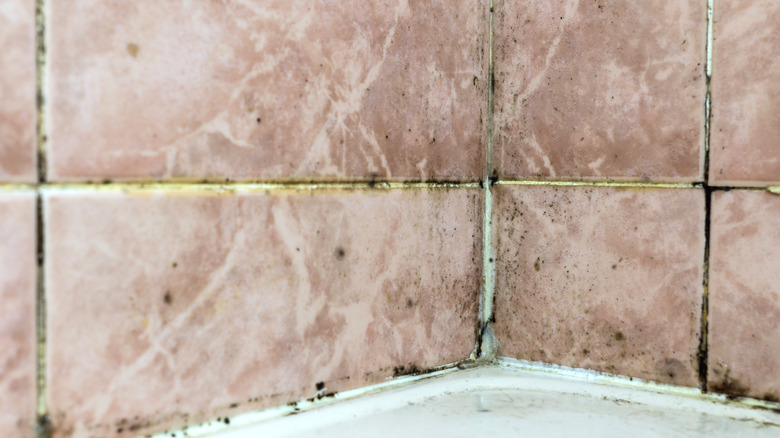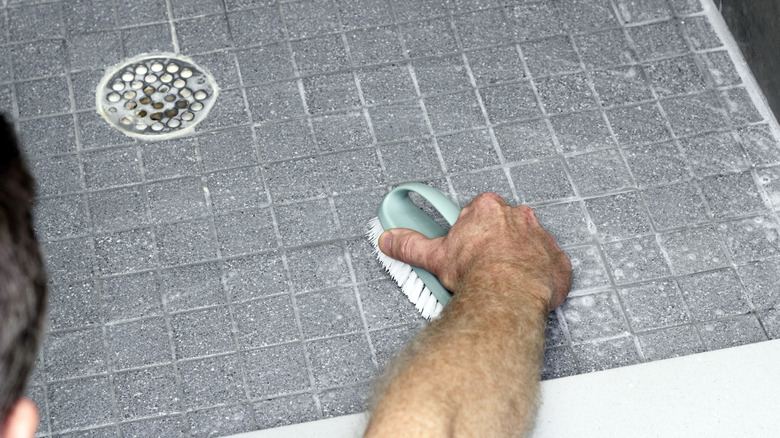The Best Way To Clean Moldy Grout Without Any Damage, According To Our Cleaning Expert
There is something satisfying about the pristine white shower environment that allows you to feel as though you are washing away the day's hard work and grime. Yet, when you step inside and notice a few black dots or areas that seem a bit dirtier than they used to be, it could be mold growth. Mold is a dangerous substance, one that absolutely needs to be cleaned away fully to minimize any risk to your health.
How do you get rid of mold that's within the grout without damaging those beautiful tiles? To find out, House Digest conducted an exclusive interview with Kathy Cohoon, Operations Manager at Two Maids, to find out what her take is. She's the first to admit it's not always an easy process, stating, "Tackling moldy grout can be a little challenging, but don't fret!"
She offers simple advice that's easy to put to work for you, sharing, "To clean moldy grout without causing damage, it's best to use a combination of mild cleaning solutions and gentle scrubbing." She also warns, "When cleaning moldy grout, it's important to take precautions to protect yourself. Wear gloves and a mask to avoid direct contact with mold and mold spores, which can be harmful if inhaled or touched. Additionally, ensure the area is well-ventilated to reduce the risk of exposure." Once you get rid of it, you can stop mold from returning to your shower so you don't face this risk again.
How to clean moldy grout safely
While most tiles in the bathroom or even in the kitchen are designed to be durable because of the water exposure present, grout is bit more problematic. As a type of mixture of sand and cement, it's quite porous, allowing for the absorption of moisture and dirt if not properly cleaned often enough. As Kathy Cohoon explained in her exclusive interview with House Digest, it's easier than you think to get rid of those mold spores. "One effective method involves whipping up a homemade paste with baking soda and water," she reveals. "Spread the paste over the moldy grout and give it a gentle scrub with a soft brush or even an old toothbrush."
With dozens of baking soda cleaning hacks out there, it's a staple you don't want to be without. Cohoon says, "Baking soda works wonders as a natural cleaner, lifting away the mold without being too harsh on the grout."
How do you actually handle the scrubbing, though? "In terms of tools and products, it's best to use a soft brush or toothbrush for scrubbing, as well as baking soda and vinegar for cleaning," shares Cohoon.
What to do when the grout is really dirty
Perhaps it's been some time since you really gave the shower a good cleaning, or you're visiting a friend's house and want to help out on a less-than-desirable space. Baking soda might work, but it may also not be enough in all situations. In her exclusive interview with House Digest, Kathy Cohoon of Two Maids offers a few more tips and strategies.
"For stubborn mold, you can also use a mixture of equal parts vinegar and water," she notes. A simple white vinegar is all it takes to make this work. "Spray the solution onto the moldy grout, let it sit for a few minutes, then scrub gently." When you use this method, you gain the added power that comes from vinegar. Cohoon reveals, "Vinegar is acidic and can help dissolve the mold, but it's important to rinse the area thoroughly afterward to prevent any damage to the grout." You don't want to soak the area with vinegar, as it may eat away at that porous grout.
Speaking of risks to this type of cleaning, Cohoon also offers a bit of added advice. "It's worth noting that while these methods are generally safe for most types of grout, it's always a good idea to test any cleaning solution on a small, inconspicuous area first to ensure it doesn't cause any damage or discoloration." Once you take these steps, keeping the area clean after every shower can keep mold at bay, protecting the grout long term.


